Abstract
The mouse T-cell tumours E1-4 and WEHI-22 produce an immunoglobulin (TCT Ig) which suppresses the antibody response to T- dependent antigens in vitro while having no effect on responses to T-independent antigens. TCT Ig also augments IgG responses to both kinds of antigen. TCT Ig appears to be a new class of mouse Ig because its effects on in vitro antibody responses can be absorbed by antisera to mouse Kappa chains but not with antisera to any of the known classes of mouse Ig. Furthermore, TCT Ig activity cannot be duplicated by free light chains, Fab2 fragments, several mouse serum Ig preparations of Ig made from B cells. TCT Ig affects only T-cell function in antibody responses. It has no effect on the ability of the different subclasses of T cells to respond to mitogens or to alloantigens. Furthermore, it does not block T-T cell co-operation suggesting that the molecular basis for T-T co-operation differs from that of T-B co-operation.
Full text
PDF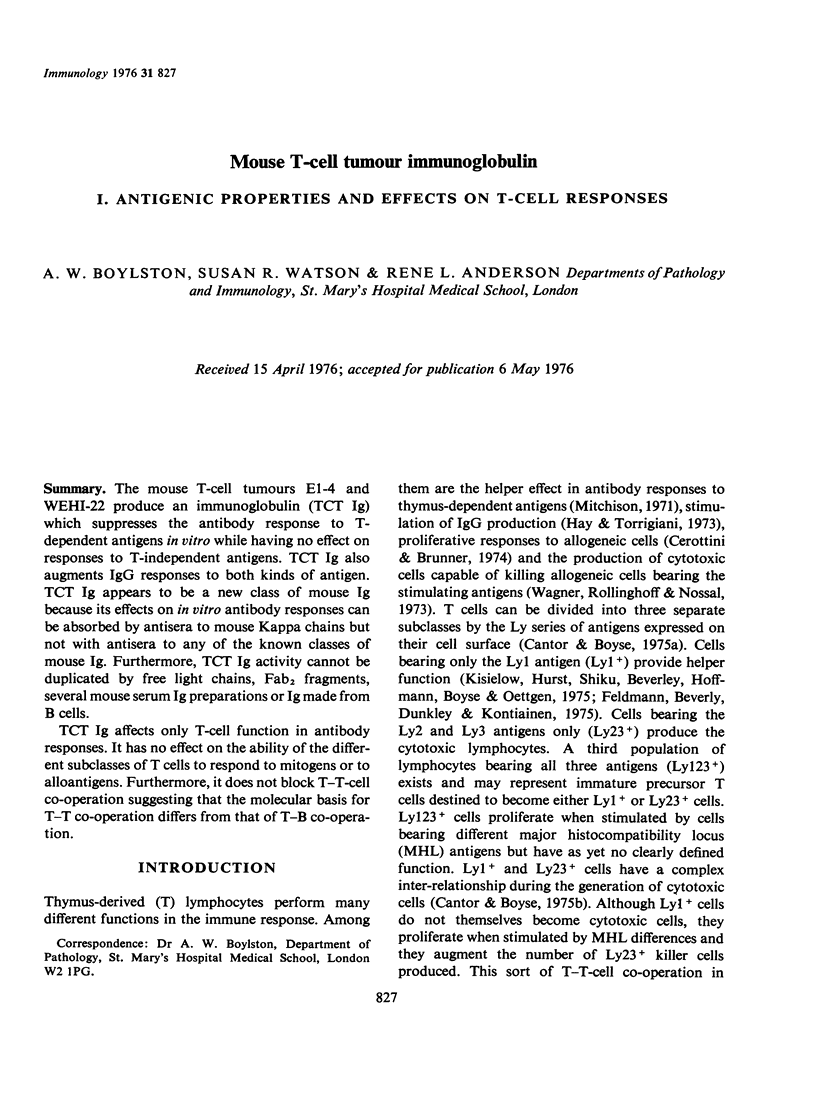
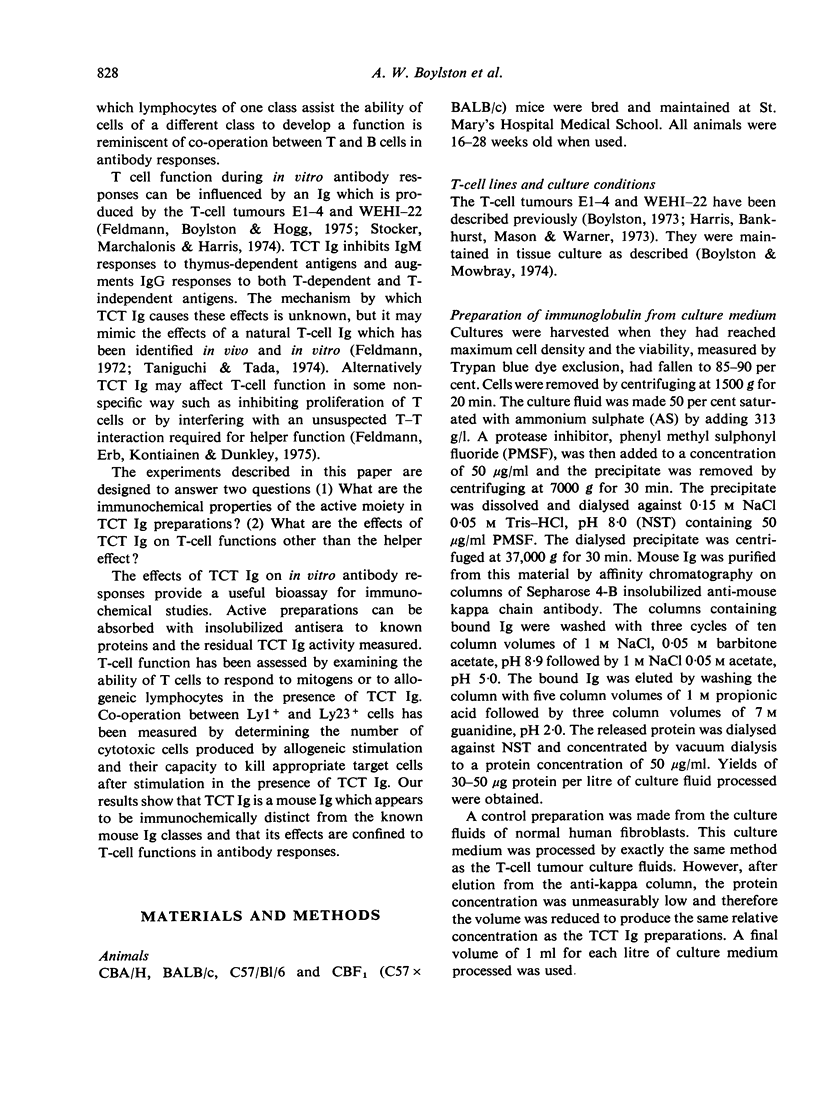
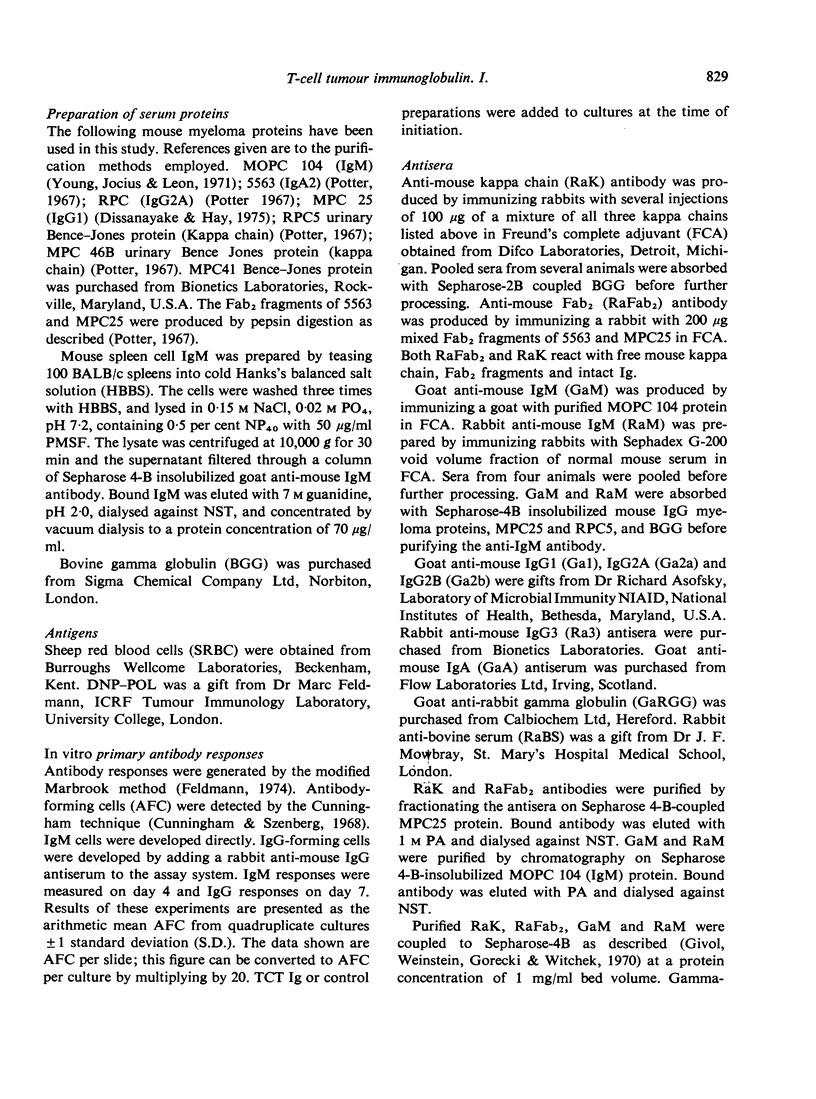

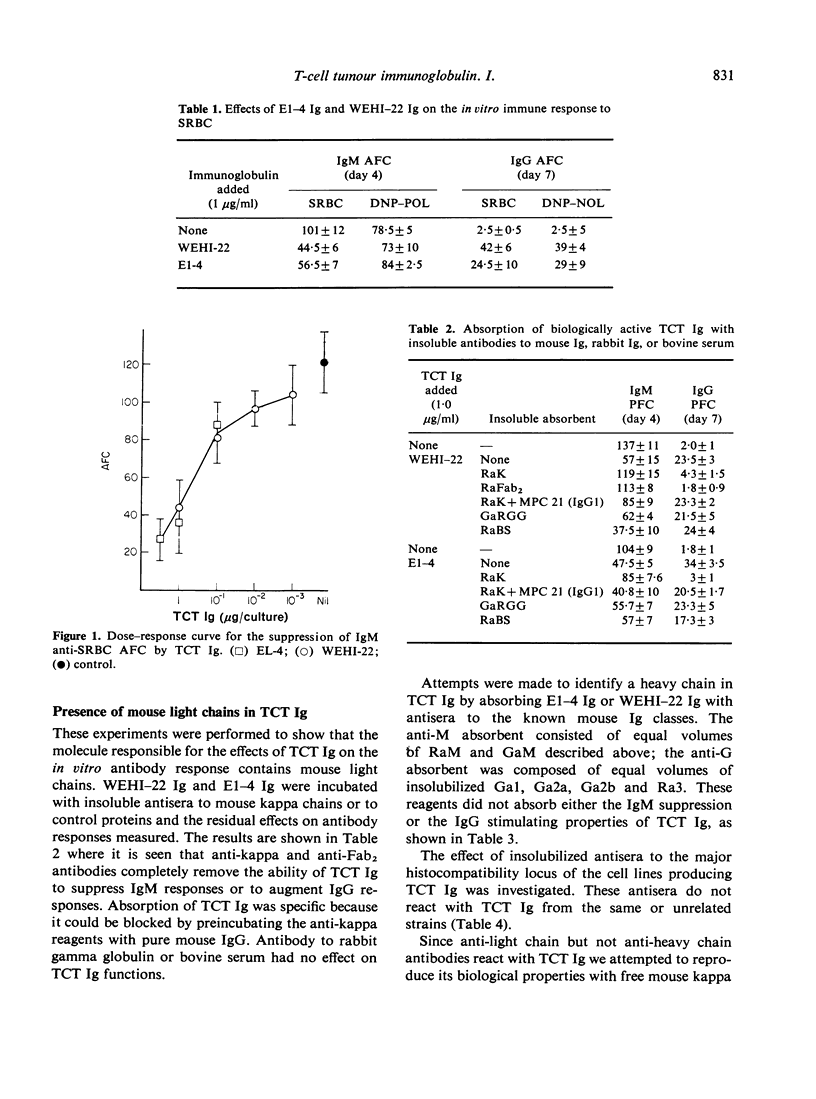
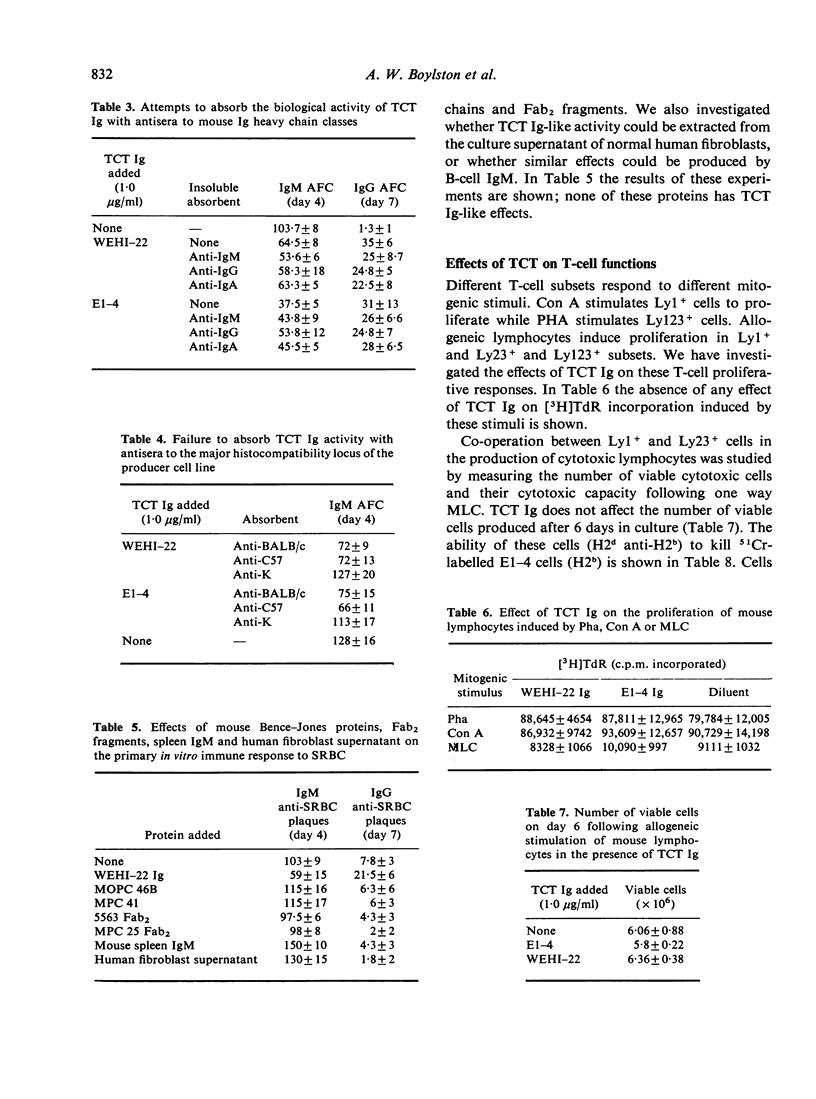
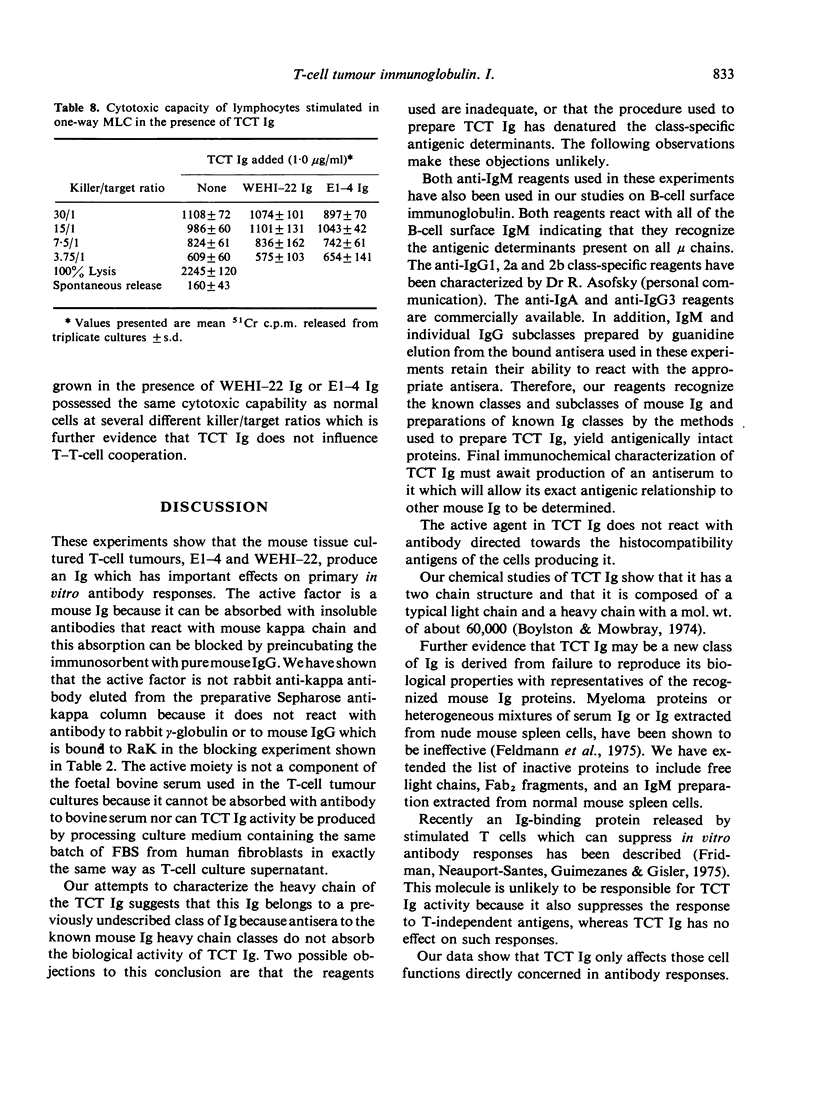
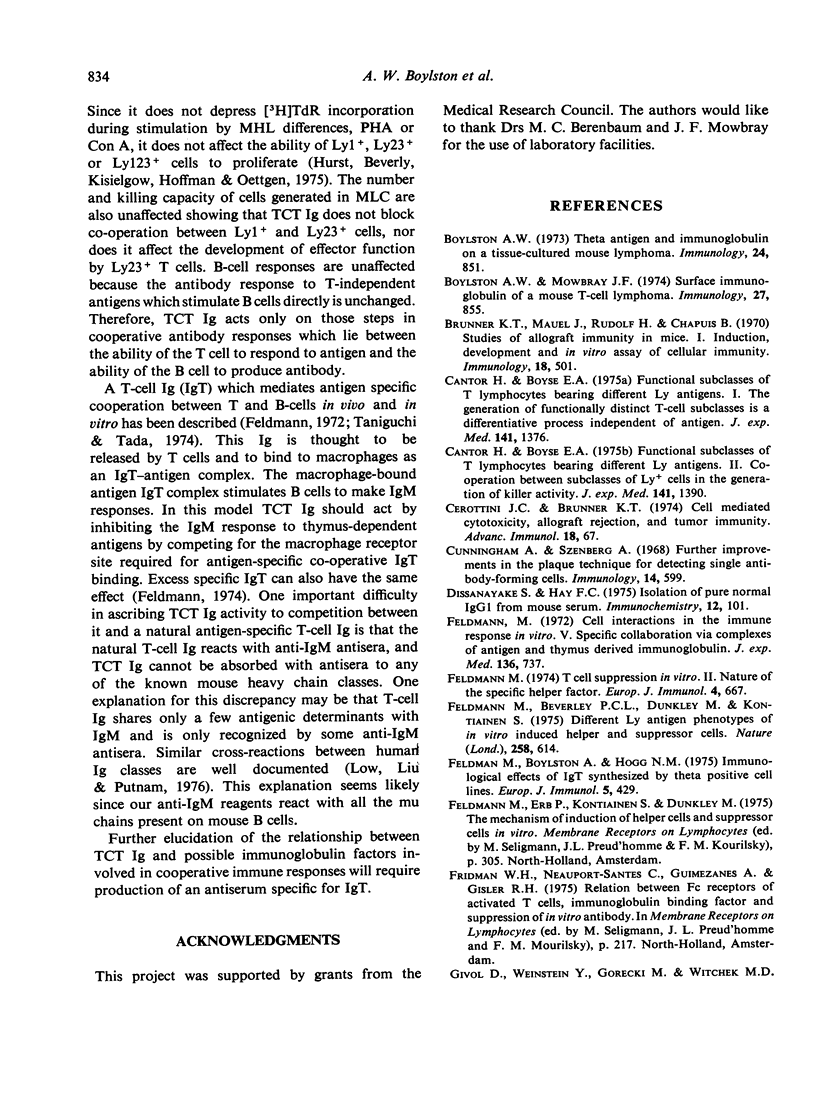

Selected References
These references are in PubMed. This may not be the complete list of references from this article.
- Boylston A. W., Mowbray J. F. Surface immunoglobulin of a mouse T-cell lymphoma. Immunology. 1974 Nov;27(5):855–861. [PMC free article] [PubMed] [Google Scholar]
- Boylston A. W. Theta antigen and immunogolbulin on a tissue-cultured mouse lymphoma. Immunology. 1973 May;24(5):851–857. [PMC free article] [PubMed] [Google Scholar]
- Brunner K. T., Mauel J., Rudolf H., Chapuis B. Studies of allograft immunity in mice. I. Induction, development and in vitro assay of cellular immunity. Immunology. 1970 Apr;18(4):501–515. [PMC free article] [PubMed] [Google Scholar]
- Cantor H., Boyse E. A. Functional subclasses of T lymphocytes bearing different Ly antigens. II. Cooperation between subclasses of Ly+ cells in the generation of killer activity. J Exp Med. 1975 Jun 1;141(6):1390–1399. doi: 10.1084/jem.141.6.1390. [DOI] [PMC free article] [PubMed] [Google Scholar]
- Cantor H., Boyse E. A. Functional subclasses of T-lymphocytes bearing different Ly antigens. I. The generation of functionally distinct T-cell subclasses is a differentiative process independent of antigen. J Exp Med. 1975 Jun 1;141(6):1376–1389. doi: 10.1084/jem.141.6.1376. [DOI] [PMC free article] [PubMed] [Google Scholar]
- Cerottini J. C., Brunner K. T. Cell-mediated cytotoxicity, allograft rejection, and tumor immunity. Adv Immunol. 1974;18:67–132. doi: 10.1016/s0065-2776(08)60308-9. [DOI] [PubMed] [Google Scholar]
- Cunningham A. J., Szenberg A. Further improvements in the plaque technique for detecting single antibody-forming cells. Immunology. 1968 Apr;14(4):599–600. [PMC free article] [PubMed] [Google Scholar]
- Dissanayake S., Hay F. C. Isolation of pure normal IgG 1 from mouse serum. Immunochemistry. 1975 Jan;12(1):101–103. doi: 10.1016/0019-2791(75)90057-9. [DOI] [PubMed] [Google Scholar]
- Feldmann M., Beverley P. C., Dunkley M., Kontiainen S. Different Ly antigen phenotypes of in vitro induced helper and suppressor cells. Nature. 1975 Dec 18;258(5536):614–616. doi: 10.1038/258614a0. [DOI] [PubMed] [Google Scholar]
- Feldmann M., Boylston A., Hogg N. M. Immunological effects of IgT synthesized by theta-positive cell lines. Eur J Immunol. 1976 Jun;5(6):429–431. doi: 10.1002/eji.1830050615. [DOI] [PubMed] [Google Scholar]
- Feldmann M. Cell interactions in the immune response in vitro. V. Specific collaboration via complexes of antigen and thymus-derived cell immunoglobulin. J Exp Med. 1972 Oct 1;136(4):737–760. doi: 10.1084/jem.136.4.737. [DOI] [PMC free article] [PubMed] [Google Scholar]
- Feldmann M. T cell suppression in vitro. II. Nature of specific suppressive factor. Eur J Immunol. 1974 Oct;4(10):667–674. doi: 10.1002/eji.1830041006. [DOI] [PubMed] [Google Scholar]
- Harris A. W., Bankhurst A. D., Mason S., Warner N. L. Differentiated functions expressed by cultured mouse lymphoma cells. II. Theta antigen, surface immunoglobulin and a receptor for antibody on cells of a thymoma cell line. J Immunol. 1973 Feb;110(2):431–438. [PubMed] [Google Scholar]
- Hay F. C., Torrigiani G. The effect of pertussis adjuvant on antibody production: the need for thymus-dependent lymphocytes. Eur J Immunol. 1973 Oct;3(10):657–659. doi: 10.1002/eji.1830031015. [DOI] [PubMed] [Google Scholar]
- Hirst J. A., Beverley P. C., Kisielow P., Hoffmann M. K., Oettgen H. F. Ly antigens: markers of T cell function on mouse spleen cells. J Immunol. 1975 Dec;115(6):1555–1557. [PubMed] [Google Scholar]
- Kisielow P., Hirst J. A., Shiku H., Beverley P. C., Hoffman M. K., Boyse E. A., Oettgen H. F. Ly antigens as markers for functionally distinct subpopulations of thymus-derived lymphocytes of the mouse. Nature. 1975 Jan 17;253(5488):219–220. doi: 10.1038/253219a0. [DOI] [PubMed] [Google Scholar]
- Low T. L., Liu Y. S., Putnam F. W. Structure, function, and evolutionary relationships of Fc domains of human immunoglobulins A, G, M, and E. Science. 1976 Jan 30;191(4225):390–392. doi: 10.1126/science.1246619. [DOI] [PubMed] [Google Scholar]
- Mitchison N. A. The carrier effect in the secondary response to hapten-protein conjugates. II. Cellular cooperation. Eur J Immunol. 1971 Jan;1(1):18–27. doi: 10.1002/eji.1830010104. [DOI] [PubMed] [Google Scholar]
- Stocker J. W., Marchalonis J. J., Harris A. W. Inhibition of a T-cell-dependent immune response in vitro by thymoma cell immunoglobulin. J Exp Med. 1974 Mar 1;139(3):785–790. doi: 10.1084/jem.139.3.785. [DOI] [PMC free article] [PubMed] [Google Scholar]
- Taniguchi M., Tada T. Regulation of homocytotropic antibody formation in the rat. X. IgT-like molecule for the induction of homocytotropic antibody response. J Immunol. 1974 Dec;113(6):1757–1769. [PubMed] [Google Scholar]
- Wagner H., Röllinghoff M., Nossal G. J. T-cell-mediated immune responses induced in vitro: a probe for allograft and tumor immunity. Transplant Rev. 1973;17(0):3–36. doi: 10.1111/j.1600-065x.1973.tb00122.x. [DOI] [PubMed] [Google Scholar]
- Young N. M., Jocius I. B., Leon M. A. Binding properties of a mouse immunoglobulin M myeloma protein with carbohydrate specificity. Biochemistry. 1971 Aug 31;10(18):3457–3460. doi: 10.1021/bi00794a022. [DOI] [PubMed] [Google Scholar]


